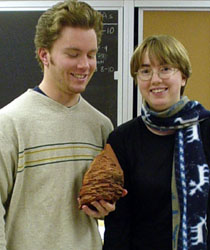The Precambrian
Cloud, 1988 suggests writing a course around the first three or four billion years of Earth history, which he referred to as the Cryptozoic. Much of the evidence we have on conditions at those times is new and rather sketchy, but thanks in part to the astrobiology initiative, our knowledge base for the Hadean and Archean is growing rapidly. In the meantime, soft-bodied fossils from the Proterozoic have been found in shales and in chert, and fierce controversies are springing up over the nature of the early atmosphere and evidence for equatorial ice sheets.
These early eons are very exciting:

- From an Earth system standpoint because the atmosphere, hydrosphere, geosphere, and biosphere went through almost all of their major changes before the Cambrian.
- To students, because the Earth was a very different world back then. For most of that time:
- There was no breathable air
- Continents (when they emerged) were positioned in strange configurations
- Until the very end, all life was microscopic
- Oceans with rather different salts
- At one point, the whole world might have been covered with ice!
- To all scientists, because as strange as those days were, they led to modern conditions.
- The anoxic atmosphere was probably necessary for the origin and diversification of the first cells.
- The cometary impacts that are now so rare brought the early Earth extra water, making the modern Earth a wetter place than it would be otherwise.
- Much of the information is new and much of it is controversial
- This part of the past is very relevant to our future: particularly for the search for life on other planets, and the possibility of terraforming other worlds
Examples
Earth: Evolution of a Habitable World is a planetary science course covering the whole of Earth history, but with emphasis on the Precambrian and Late Quaternary.
A course that focuses on a Precambrian topic is David Reis' interdisciplinary course Wonderful Life: Genes and Evolution: which deals with evolution from 4.5 billion years ago to the Cambrian (the time of the Burgess Shale deposits).
Some Topics
- The formation of the Earth: one could start with the Big Bang, or the origin of the solar system. The formation of the moon and evidence for the first tides are also major events. The sun has experienced some major changes: the T-tauri winds and the gradual increase in radiation output have also affected the Earth.
- The first continents: The first "continents" were very small, as it took a while for lighter rocks to accrete into continental crust and for those microcontinents to join up. Nonetheless, at least two supercontinents (Columbia and Rodinia) are thought to have formed and broken apart before the Phanerozoic. The volume and effects of meteoric and cometary impacts during the Hadean are poorly understood.
- The origin of life: Where did the first organic molecules form: in space (delivered to Earth by cometary impacts) or in undersea volcanic vents? Likewise, there is considerable debate about whether membranes, RNA, and DNA formed and replicated independently before the first cell. How long ago did the first cell form and how similar was it to modern prokaryotes? This quandary is highly relevant to our search for life elsewhere in the galaxy, even our own Solar System. Even non-Earthlike planets may host life; the Earth on which our ancestors evolved was very different from the modern Earth.
- the Oxygen Revolution: Earth's early atmosphere was low in oxygen, much like those of modern Venus and Mars (carbon dioxide and nitrogen). Banded iron formations indicate that the ocean was rich in iron salts, which would not be soluble in an oxygen-rich atmosphere. These stopped forming about 1.8 billion years ago and are buried under red beds, indicating higher levels of atmospheric oxygen. How rapid was the increase in oxygen? What was the effect on the biota? What role did plate tectonics play in the change?
- Snowball Earth: This is a hotly debated theory. There are diamictons in all continental sediments 700-600 million years old, and banded iron formations in all marine sediments of that age (the only ones since 1.8 bya). Paleomagnetic evidence shows the continents lined up at the equator, but opponents of the theory say that global glaciation would have exterminated almost all eukaryotic life.
- The Ediacaran fauna/Cambrian Explosion: The original mystery of the Cambrian Explosion was how all modern animal phyla seemed to have evolved from apparently nothing about 540 million years ago. However, we now have older fossils, including those of animals. Some of the oldest animals do not appear to belong to any modern phylum.
